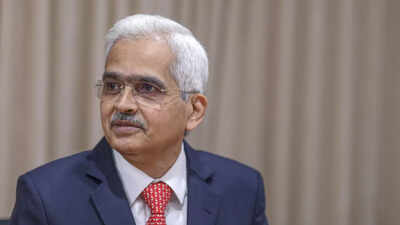Top Searches
- News
- Business News
- India Business News
- RBI raised rates at right time, says Shaktikanta Das
RBI raised rates at right time, says Shaktikanta Das

RBI Governor Shaktikanta Das (Bloomberg)
MUMBAI: Reserve Bank of India governor Shaktikanta Das said that the economy would have suffered had the central bank tightened monetary policy earlier than it did. The governor said that India’s monetary policy framework provides flexibility to ensure that economic resilience and financial stability with a clear objective that when situation stabilises inflation will be brought within target.
Das explained the rationale behind the central bank’s policy measures in his speech at a banking conclave organised by FICCI and the Indian Banks Association. The speech comes a day ahead of the monetary policy committee meeting to discuss a communication to the government on why the inflation target of 4% could not be maintained.

Das said that the RBI has eased policy as part of pandemic measures and announced measures to tighten monetary supply after the Ukraine war started in April. He said that while the inflation target was missed, it was important to see what the alternative would have been. “It (tightening earlier) would have been very costly for the economy. It would have been very costly for the citizens ofthis country. We would have paid a high cost,” he said.
The governor said that while the RBI did not have the freedom to make public the contents of the letter to the government, it would be a matter of time before the contents are disclosed as the MPC framework is built on transparency.
“Bank of England has been writing this letter every month for the last one year. Other central banks write similar letters. However, our MPC framework is quite recent and was instituted only in 2016,”said Das. The governor compared the inflation targeting exercise with the challenge faced by Arjuna in the Mahabharata when he had to shoot an arrow at the eye of a revolving fish by looking at its reflection in the water.
Das said that liquidity situation would ease as cash leakages from the system due to festivals would return and the government spending picks up. He said capital outflows that were being witness were a reflection of the liquidity.
Das explained the rationale behind the central bank’s policy measures in his speech at a banking conclave organised by FICCI and the Indian Banks Association. The speech comes a day ahead of the monetary policy committee meeting to discuss a communication to the government on why the inflation target of 4% could not be maintained.

Das said that the RBI has eased policy as part of pandemic measures and announced measures to tighten monetary supply after the Ukraine war started in April. He said that while the inflation target was missed, it was important to see what the alternative would have been. “It (tightening earlier) would have been very costly for the economy. It would have been very costly for the citizens ofthis country. We would have paid a high cost,” he said.
The governor said that while the RBI did not have the freedom to make public the contents of the letter to the government, it would be a matter of time before the contents are disclosed as the MPC framework is built on transparency.
“Bank of England has been writing this letter every month for the last one year. Other central banks write similar letters. However, our MPC framework is quite recent and was instituted only in 2016,”said Das. The governor compared the inflation targeting exercise with the challenge faced by Arjuna in the Mahabharata when he had to shoot an arrow at the eye of a revolving fish by looking at its reflection in the water.
Das said that liquidity situation would ease as cash leakages from the system due to festivals would return and the government spending picks up. He said capital outflows that were being witness were a reflection of the liquidity.
FOLLOW US ON SOCIAL MEDIA
FacebookTwitterInstagramKOO APPYOUTUBE
Start a Conversation
end of article









